Graphic of Durban Beach is via Wikimedia
Suburbs, neighbourhoods and townships with names that occur only in Scotland and not elsewhere in the British Isles and/or are definitely or most probably of Scottish origin, are:
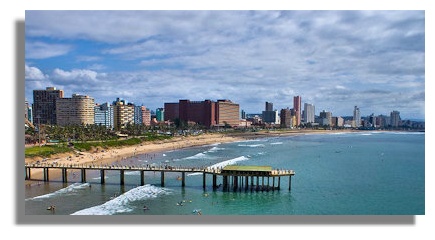 For comparability with other cities around the world, Greater Durban (eThekwini in Zulu) has been defined as the continuously built up area bounded by Inanda, Verulam and Umhlanga Rocks in the north and Illovo in the south, stretching inland as far west as Drummond and KwaNdengazi. Of the names of the 500 urban and semi-urban suburbs, neighbourhoods and districts that have been identified to date in metropolitan Durban, 71 (14.2%) can be found in Scotland or are based on Scottish family names or Scottish words. Of course, many of the names are used in other parts of the British Isles as well, but at least 27 (5.4%) appear to have a definite connection with Scotland, or are readily identifiable with places in Scotland that are based on the same names.
For comparability with other cities around the world, Greater Durban (eThekwini in Zulu) has been defined as the continuously built up area bounded by Inanda, Verulam and Umhlanga Rocks in the north and Illovo in the south, stretching inland as far west as Drummond and KwaNdengazi. Of the names of the 500 urban and semi-urban suburbs, neighbourhoods and districts that have been identified to date in metropolitan Durban, 71 (14.2%) can be found in Scotland or are based on Scottish family names or Scottish words. Of course, many of the names are used in other parts of the British Isles as well, but at least 27 (5.4%) appear to have a definite connection with Scotland, or are readily identifiable with places in Scotland that are based on the same names.
- Albany - there is an Albany Burn in South Ayrshire. Although Albany occurs in some English place names as well, the origin of the name is Scottish. Albany/Albion is derived from the ancient Celtic name for Britain, giving rise to 'Alba' as the Modern Gaelic name for Scotland. It is also a peerage title that is sometimes given to the younger princes of the British royal family. The title is a Scottish one and was first conferred in 1398 upon Robert, brother of Robert III (born John) of Scotland. The title was last given to Prince Leopold George Duncan Albert, youngest son of Queen Victoria, created Duke of Albany in 1881 - a title to which his posthumous son, Arthur Charles Edward, succeeded in 1884. The reason for naming this Hillcrest suburb has not been found.
- Alexander Park - Alexander is a Scottish family name, branches of the family being septs of Clans MacAlister, MacDonald or MacDonnell of Glengarry, though the name has since travelled to England, for example, Alexander House in Kent. No information has been found on the origin of the name of this Pinetown suburb. One wonders whether the name was given in honour of Henry Alexander (ancestry not reported), who served a brief term as Governor of Natal in 1880.
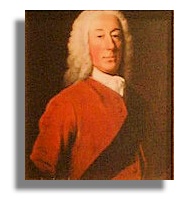
- Atholl Heights (Atholl in Perth & Kinross). The Westville suburb is "said to have been named by Scottish residents after the Duke of Atholl (graphic shows an early Duke of Atholl); the ducal title is derived from the district of Atholl (or Athole) in Perthshire, Scotland." (Raper, 1989, p. 35). Most of the streets in Atholl Heights have Scottish names, a theme which continues into the neighbouring suburb of Chiltern Hills.
- Atholton - no information has been found on the reason for the name of this suburb in the Mount Edgecombe area but, like Atholl Heights (see above), a Scottish connection seems probable.
- Barrs Flats - numerous places in Scotland have Barr as an element in their name. Examples include the towns of Barr (Argyll & Bute and South Ayrshire), Barrhead (East Renfrewshire), Barrhill (South Ayrshire) and Barrmill (North Ayrshire), Barr Burn (a water feature in Dumfries & Galloway) and many mountains and hills (Barr Dubh, Barr nan Cadhag, etc.). Barr is a Gaelic word meaning 'head, top, tip or summit'; it is also a Scottish surname. Barr occurs in several English place names as well but is encountered less commonly as an English family name. No information has been found to account for the name of this suburb of Verulam.
- Bayhead (Western Isles; also Highland spelt Bay Head - the only occurrences of the name in the British Isles). It is very probable, however, that the name of this industrial suburb is purely descriptive of its location at the head of the Bay of Natal, with no intended reference to any particular place in Scotland.
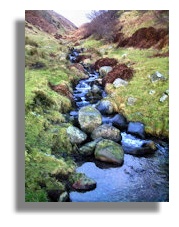
- Burnside (two places in Angus and one place in each of Fife, Moray and West Lothian). Burnside is a descriptive name, burn being the Scots word for a stream. The burn in the graphic is the Burn of Care at Castle Campbell (formerly Castle Gloom) in Clackmannanshire. No information has been found on the origin of the name of this locality in the Umhlanga Rocks area.
- Cowie's Hill and Cowie's Hill Park - there is a place in Aberdeenshire spelt Cowieshill. Cowie is also a Scottish surname - in Aberdeenshire it is pronounced "Cooie". These suburbs owe their name to William Cowie, the son of Scottish settlers who arrived in South Africa in 1820. William Cowie married an Afrikaans farmer's daughter and came to Natal in late 1837 with the Voortrekker group led by J J Uys and his son Pieter. Cowie was one of the party of six Voortrekkers, sent by K.P. Landman, to meet with the British at Port Natal on 18 April 1838 to negotiate their settlement in the area. According to a letter, found at the Deeds Office in Pietermaritzburg, dated 15 February 1851, written by William Swan Field to Governor Benjamin Pine, on 11 July 1844 the farm 'Tafelberg' was sold by Andries van Tonderen to William Cowie for the sum of £225. A nearby hill known originally as Steilhoogte ('steep heights') became known as Cowie Hill, from which the modern suburbs eventually took their name (Kloof Falls Lodge website, drawing on an unpublished manuscript: 'A History of Kloof, Natal' by Meredith Mary Shadwell).
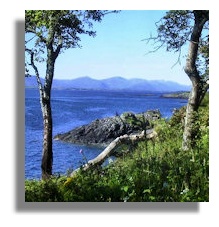
- Doonside (Dumfries & Galloway). This suburb on the south coast was originally known as Middleton. To avoid postal confusion with Middleton in the Cape Province, the name was changed to Doonside in 1910. It is said that a Mr. W.A. Dicker, a settler from Devon then living in a cottage he called 'Lorna Doone' overlooking the railway station, suggested the name Doonside (Stayt, 1971). Lorna Doone is of course the title of the well-known novel by the English author Richard D. Blackmore (1825-1900), the setting of which was in Devon and Somerset. According to Webster's Dictionary, Lorna is a name that was apparently coined by R.D. Blackmore from the title of the Marquis of Lorne (1845-1914), Lorne being a Scottish name (the Firth of Lorne is shown in the graphic here). Doone also has a Scottish feel to it ("doon" is the Scots word for "down")and was probably similarly selected by Blackmore to sound Scottish. Whilst the primary association of Doonside as a Durban place name is with English literature, the name of this suburb can nevertheless be claimed as Scottish.
- Doon Heights (Doon in East Lothian, Dumfries & Galloway and South Ayrshire) also three places in Ireland called Doon. The proximity of this suburb to Doonside (see above) suggests that the name is indirectly derived from the novel 'Lorna Doone'. It is possible, of course, that any of the places in Scotland might also have influenced the choice of name.
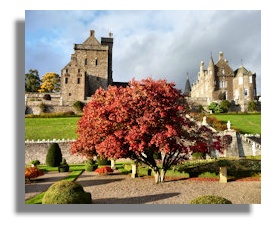
- Drummond - there are places in Stirling and the Highlands called Drummond, based no doubt on this Scottish family name. Three theories have been advanced to account for the name of this suburb in the far west of metropolitan Durban. Raper (1989) and Stayt (1971) both attribute the name to Sir Charles F. Drummond, former director of the Natal Land and Colonisation Company, who visited the area in connection with a plan to colonise it. Stayt points out, however, that there have been other suggestions as to its origin. "One is that it was named after a certain Capt. Drummond who eventually settled somewhere in the Cape but who was well-known in the area at one time and another is that the name recalls the visit to Natal of a well-known White hunter named John Drummond." (Stayt, 1971).
- Duff's Road - there is a Duff's Hill and Duff House in Aberdeenshire and Duff's Loch in Dumfries & Galloway. The Duffs are a sept of Clan MacDuff, immortalised in Shakespeare's MacBeth. This suburb, in the KwaMashu area, was named after Thomas Duff, a storekeeper who arrived in 1850 and planted sugar cane in the area in about 1872 (Raper, 1989, p. 127). Stayt (1971) adds that "Thomas Duff came to Natal with his father in 1850 and after trying unsuccessfully to farm in the Verulam district went to Zululand as a trader. In 1860 Duff returned to Natal and settled at Duff's Road where he farmed and traded." Thomas Duff is listed as one of the passengers aboard the 'Ina', which sailed from Greenock, Scotland to Port Natal in 1849.
- Glen Park (Renfrewshire). The proximity of this suburb to Highland Hills (see below) strengthens the likelihood that the name has a Scottish connotation.
- Glenwood (Aberdeenshire). According to Raper (1989, p. 179), the name of this suburb was probably taken from that of an estate called Upper Glenwood at the southern tip of the Berea. Glenwood has proved to be a popular choice as a place name in many cities around the world.
- Hagart Road Industrial - there is a Hagart Road in Johnstone, Renfrewshire. Black (1996), the authority on Scottish family names, lists Hagart and Hagard as corruptions of MacTaggart, adding that Hagart/Hagard was "not uncommon" in Perthshire in the 16th and 17th centuries.
- Highland Hills (possibly recalling the Highlands of Scotland). Most of the streets in this suburb have names that suggest a Scottish theme: Argyll Road, Caber Road, Cameron Road, Clyde Avenue, Fife Place, Grant Place, Heather Road, Highlands Road, Oban Place, Seaforth Avenue, Skye Place and Thistle Road.

- Kenneth Gardens - Kenneth is both a Scottish family name (a sept of MacKenzie) and a personal name (Coinneach in Gaelic). Kenneth MacAlpin (pictured here) was the king under whom the Picts and Scots were first united in the 9th century.
- KwaMashu - Local historians are in agreement that this Zulu place name is part Scottish. "The name is a Zulu adaptation of Marshall and means 'the place of Marshall', referring to Sir Marshall Campbell (1848-1917), former member of the legislative Assembly of Natal." (Raper, 1989, pp. 282-283). Sir Marshall was a sugar magnate and was also responsible for introducing rickshaws to Durban. According to Stayt (1971), the Zulus held Sir Marshall "in very high regard" as "friend and protector." 'Muckleneuk', his family home in Berea is now home to the Campbell Collection comprising furniture, the Mashu Museum, Zulu arts and crafts and the Killie Campbell Africana Library and Museum (Erasmus, 2004, p. 231). An article posted to the University of KwaZulu-Natal website (http://campbell.ukzn.ac.za/?q=node/47363) has the following to say about Sir Marshall Campbell: "Marshall Campbell was only two years old when he first arrived in Durban with his parents, William John and Agnes Campbell. They had sailed from Glasgow, Scotland on the 'Conquering Hero', which, after a voyage of 90 days, dropped anchor off Durban on the 28th June 1850. The Campbells were settlers under the Byrne emigration scheme, whereby between 1849 and 1851 some 2 500 people, mainly from England and surrounds, came to Natal."
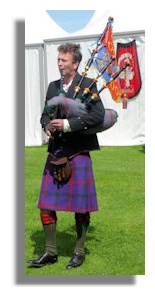
- Lamontville - Lamont, or MacLaomainn in Gaelic, is a small Scottish clan (the graphic shows a piper of the Lamont clan in their striking tartan kilt), well established by the middle of the 13th century. According to Scarlett (1975), the origin of the name is said by one authority to be a Norse word for 'lawman', though the name could also have been derived from Lomond. Raper (1989, p. 290) states that the suburb was laid out in 1930 and named after the Reverend Archibald Lamont, who was the Mayor of Durban at the time. There is an entry in the New Dictionary of South African Biography, Vol. 2 (edited by N.E. Sonderling) concerning the Rev. Lamont which reads as follows: "14 September 1864: Archibald Lamont, minister of religion, politician and mayor of Durban from 1929-1932, is born in Port Babbabtyne, Bute Island, Scotland. Lamont township (currently Lamontville) was named after him at the insistence of the Black people for whose cause he has campaigned so diligently." (www.sahistory.org.za/pages/chronology/thisday/2006-09-10-16_extra-dates.htm) Port Babbabtyne is doubtless a typographical error (there is a Port Bannatyne on the Isle of Bute). It is nevertheless evident that Lamontville is a Scottish name.
- Morningside (Dumfries & Galloway, City of Edinburgh, North Lanarkshire and Perth & Kinross). Morningside is one of the most commonly recurring Scottish place names in cities around the world, especially in South Africa and the USA.
- Queensburgh - According to Raper (1987, p. 274), this former municipality was "named in honour of Queen Elizabeth II of Great Britain who was crowned in 1952." Queen Elizabeth is half Scottish through her mother. It is possible that the suffix 'burgh' may have been selected in preference to the English 'borough' to acknowledge this fact. The more likely explanation, however, is the existing use of this suffix in the names of other nearby suburbs (Kingsburgh and Rossburgh) as well as Scottburgh, located on the South Coast beyond the metropolitan area.
- Rossburgh - this name does not occur in Scotland but nevertheless has a distinctly Scottish ring about it. Places called Ross can be found in the Scottish Borders, Dumfries & Galloway, Highland and Perth & Kinross. There are also many other places throughout Scotland that have Ross as part of the name. However, the same is true for England and Ireland, though less commonly so than for Scotland. Ross is of course a fairly common Scottish family name originating nearly 900 years ago from two very different sources: Yorkshire in northern England (the Ayrshire Ross's) and that part of the Highlands of Scotland once known as Ross-shire. According to Raper (1989), Rossburgh commemorates Merry Ross, a medical practitioner who lived there. The name was bestowed in 1926; prior to that date the name South Coast Junction was used.
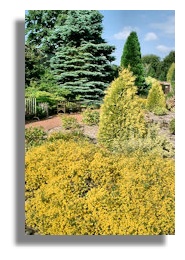
- Rouken Glen - an urban public park in Giffnock, East Renfrewshire, once owned by the Earl of Eglinton, 'Rouken' meaning 'Rock End'. One presumes that the small neighbourhood of Rouken Glen in the suburb of Westville was named for the park in Scotland (pictured here), which is situated in the Greater Glasgow area.
- Sea View (Highland, spelt Seaview) also two places in England, spelt Seaview. Raper (1989) states that the suburb is said to have been named because it was the first place from which a traveller to Durban could obtain a clear view of the sea. A Scottish connection with this suburb is evident from the fact that Seaview was the site of Robert Dunn's old 'Seaview' estate (Stayt, 1971). Robert Newton Dunn (1795-1847) was born in Scotland, emigrated to the Eastern Cape in 1820 and came to Port Natal in 1836. Dunn was trampled to death by an elephant; his son was the legendary John Dunn (1836-1895), a hunter who shot the last elephant in Natal, became a Zulu chieftain and is said to have fathered more than 117 children by 48 Zulu wives. Dunn's Reserve, on the KwaZulu-Natal North Coast, was named in his honour.
- Silver Glen (Clackmannanshire). It is unlikely, however, that the name of this suburb, in the Chatsworth area, is actually Scottish since most of the streets have botanical or rustic sounding names.
- Woodhaven (Fife). Like Silver Glen (see above), the name of this suburb might be only coincidentally Scottish since it is a popular name in several cities, mainly in Canada and the USA.
Some of the following suburbs and neighbourhoods may also prove on further investigation to have a direct or indirect Scottish connection, but these names are associated with other parts of the British Isles as well. There is nothing intrinsically 'Scottish' about most of these names, however.
- Belvedere (West Lothian). Belvedere is also found in England, most famously in London, and there is also the Belvedere Palace in Vienna, Austria. It is unlikely that the name of this Hillcrest suburb has a Scottish connection. A more plausible explanation might be the suburb's location in hilly terrain affording good views (Belvedere is an Italian word for a panoramic viewpoint, 'bel' meaning 'fine' and 'vedere' 'to see').
- Blackburn and Blackburn Estate - Blackburn is a descriptive term and is found as a place name in several parts of Scotland (in Aberdeenshire, Scottish Borders, Dumfries & Galloway, Highland, Moray, South Lanarkshire and West Lothian). However, being a descriptive name it is found just as frequently in northern England, including the large town in Lancashire.
- Carrington Heights - there is a Carrington and Carrington Mill in Midlothian; however, there are also three places in England called Carrington. One wonders whether this suburb was named in honour of Lieutenant-General Sir Frederick Carrington (born 1844) who served in Zululand during the troubles there in 1888 and again during the Second Anglo-Boer War, in which event the connection would be English and not Scottish.
- Castle Hill (Aberdeenshire, Angus, Dumfries & Galloway, Highland, Moray, North Ayrshire and South Lanarkshire; also Castlehill in Ayr) but found just as frequently in England and is also found in Wales. With all the streets bearing names that have obviously been made up but which all end in 'castle', it is likely that Castle Hill is a developer's name, chosen for its marketability. The same is probably true for the adjacent neighbourhood of Steelcastle where all street names also end in 'castle'.
- Earlsfield (Aberdeenshire) but also the name of two places in England including a suburb of London.
- Glebe - there are places called Glebe in Highland, Orkney Islands and Shetland Islands. However, there are also three places in England called Glebe and two in Ireland. Glebe is an Old English word for land put aside for church use. The Glebe district of Inanda probably takes its name from a religious establishment in the area.
- Glen Anil, Glen Hills and Glenashley - no information has been found on the origins of the names of these neighbouring suburbs in Durban North but the element 'Glen' could suggest a Scottish (or possibly Irish) inspiration. However, these particular names are found in neither Scotland nor Ireland. Considering that the streets in both Glen Anil and Glen Hills appear to have been named after exotic shrubs, plants and dyes, Anil is possibly a reference to the indigo shrub, native to South America and the West Indies. Similarly, most of the streets in Glenashley appear to have been given personal names like Ashley, Aubrey, Betty, etc. It is therefore highly probable that the names of all three suburbs have no Scottish connection beyond the use of the term 'glen'.
- Glenmore (Argyll & Bute and Highland as well as a village across the border in Cumbria). However, Glenmore is also found in Ireland, the name being derived from the Gaelic, the meaning of which is 'great valley'. The street names in this suburb provide no clues as to the possible Scottish origin of the suburb's name.
- Hatton Estate - Places called Hatton can be found in Aberdeenshire, Angus, Fife, Moray, Perth & Kinross, Renfrewshire. However, there are also places called Hatton in at least six English counties and cities, including London.
- Kingsburgh (Isle of Skye - the place where Flora MacDonald died in 1790). The origin of the name of this suburb, which has also been spelled Kingsborough in the past, is uncertain. Raper (1989, p. 262) states that it was "probably named after Richard Philip (Dick) King (1811-1871) who rode along here from Durban to Grahamstown on horseback to secure assistance for beleaguered British troops in 1842." If this is correct, then the name is English and not Scottish since Dick King was born in Chatham, Kent.
- Longcroft (Aberdeenshire, Scottish Borders, Falkirk and Renfrewshire) also four places in England.
- Lotus Park and Lotusville - there is a Lotus and Lotus Hill in Dumfries & Galloway, the only occurrence of Lotus as a place name element anywhere in the British Isles. The names of these suburbs might be only coincidentally 'Scottish'. Situated as they are in predominantly Indian residential areas (Isipingo and Verulam respectively) the names are more likely to refer to the lotus plant, revered by Hindus.
- Manners - there are places called Mannerston in Falkirk and The Manners Stone in Highland but the name may just as likely refer to Manners Wood in Derbyshire, England. Manners may also refer to an individual, which would make this an English rather than a Scottish name, or possibly even Irish (Manners is said by some sources to be derived from the Irish McManus).
- Montford (Argyll & Bute) also two places in England. Considering that this suburb is located in the predominantly Indian residential area of Chatsworth, it is possible that the name is a reference to the Government of India Act, which was passed by the British Parliament in 1919 and which was also known as the Montford Reforms (or the Montagu-Chelmsford Reforms). This is a distinct possibility given that there are also three Durban suburbs, fairly close to Montford, called Chelmsford Park, Chelmsfordale and Chelmsfordville. Information on the individual whose name is associated with the Government of India Act has not been found but since Montford is an English family name of Norman origin, a Scottish connection seems unlikely.
- Mount Vernon (a district of the City of Glasgow) but also found in Lancashire, England. It is more probable, however, that the name comes from the USA, Mount Vernon being President George Washington's home in Virginia.
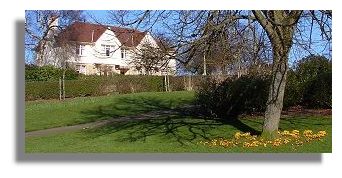
- Newlands East and Newlands West - there are places called Newlands in Aberdeenshire, Angus, City of Glasgow (that's Newlands Park in Glasgow shown here), Dumfries & Galloway, East and South Ayrshire, East Dunbartonshire, East Lothian, Highland, Moray, Perth & Kinross, and Scottish Borders. Newlands occurs even more frequently in England than it does in Scotland. Of course, the names of these Durban suburbs may have been borrowed from Cape Town or Johannesburg, in which event there would be no connection with Scotland.
- Newtown (Aberdeenshire, Argyll & Bute, Falkirk, Highland and Shetland Islands) but is far more common in England, and is also found in Ireland, Wales and the Isle of Man. The name of this neighbourhood in the KwaMashu area is likely to be purely descriptive, with no intended reference to any particular place in the British Isles.
- Old Mill Industrial (there is an Old Mill in Highland and Old Mill Burn in Dumfries & Galloway) but Old Mill is found more frequently in England.
- Paradise Valley - there is a Paradise in Aberdeenshire and Fife but Paradise is also found as an element in many place names throughout England. Like many of the names in this category, Paradise Valley probably has no intended reference to places in the British Isles.
- Preston and Prestondale - there are several places in Scotland called Preston but the name is even more commonly encountered in England. As a family name, Preston is more typically English than Scottish. No information has been found on the origin of the names of these Pinetown and Umhlanga suburbs.
- Rosehill (Aberdeenshire, Angus, Argyll & Bute, Dumfries & Galloway, Highland, Midlothian, Moray, Orkney Islands, South Lanarkshire and Stirling) though found just as commonly in England and Wales. Rosehill / Rose Hill is a popular suburban name in many cities throughout the English-speaking world.
- Springfield, Springfield Flats and Springfield Park - there are places called Springfield in Argyll & Bute, Dumfries & Galloway, Fife, Highland and Perth & Kinross. Springfield is also found in England and Wales and is a popular name in American and other South African cities as well. According to Raper (1989, p. 512), the suburb of Springfield was named after the farm on which it was laid out. The origin of the name is probably purely descriptive.
- Whitehouse (Aberdeenshire, Angus, Argyll & Bute, Scottish Borders, Moray and Perth & Kinross) also found in three English counties and is found in Ireland and the Isle of Man as well. No information has been found on the reason for the name of this suburb in the Phoenix area.
- Woodside (Aberdeen City, Dumfries & Galloway, City of Glasgow, Fife, Moray, North Ayrshire, Perth & Kinross) but even more commonly found throughout England. The Pinetown suburb was probably named for purely descriptive reasons.
A final category of suburban names comprises places that can be found in Scotland but which, in Durban's case, definitely or most probably have no connection with Scotland.
- Ashley - there are a few places in Scotland called Ashley (in the City of Edinburgh, Highland and Perth & Kinross) but this name is far more popularly used throughout England. According to Stayt (1971), this suburb of Pinetown was named after the property owner's birthplace in the English county of Kent.
- Greenwood Park - there is a Greenwood in the Scottish Borders, Moray and South Lanarkshire but the name is also frequently used in England and Ireland. It is one of the most popular British place names to have travelled the world, possibly because of its association with Robin Hood's "The Greenwood" or Thomas Hardy's "Under the Greenwood Tree", published in 1872. According to Stayt (1971), the name of the Durban suburb is supposedly attributable to Lieutenant Francis Farewell, "the father of Port Natal" who when he first set eyes on the area saw a dense green forest. Since Lieutenant Farewell was born in Somerset, England, and assuming that he was responsible for the name, it is unlikely that any of the places in Scotland contributed to the choice of name. The streets in this suburb have a mix of names with largely English and Scottish connections. For the record, those streets with Scottish names include Ardrossan Road, Ben Nevis Road, Clyde Road, Leven Place, Montrose Road, Scotia Terrace, Skye Lane and Tweed Road, and possibly also Bellhaven Road and Heather Grove. Falkirk Avenue also belongs to this cluster of streets with Scottish names, but is located in the neighbouring suburb of Avoca.
- Park Hill - there are places called Park Hill in the Scottish Borders, Dumfries & Galloway and South Ayrshire as well as Parkhill in Aberdeenshire, Angus, Fife, Inverclyde and Perth & Kinross. Park Hill/Parkhill is found even more commonly in many English counties. Raper (1989, p. 433) states that the name of the Durban suburb was made up from the names of two neighbouring suburbs - Greenwood Park and Red Hill. Since neither of these names appears to have a link with Scotland, the same would be true for Park Hill.
- Point (Highland) also two places in Cornwall and Devon. In Durban's case, the name is purely descriptive of its geographical position at the entrance to Durban Harbour (Port Natal) and was known as Point Fynn in very early days.
- Red Hill (Aberdeenshire) but the name is even more popular in England. According to Stayt (1971), the suburb takes its name from a farm in the area owned by William Lister who, together S. Beningfield "successfully grew coffee until the deadly leaf and bark disease wiped out the plantation." Raper (1989, p. 461) states that the name apparently refers to the red soil of a hill (which is by far the most common reason for naming a place Red Hill in several cities around the world).
- Riverside (Stirling) also in England and Wales. The name is no doubt simply descriptive of the suburb's location on the Umgeni River.
- Virginia (Orkney Islands) also used as a place name in England, Ireland and the Isle of Man. Considering, however, that the Durban suburb has street names such as Potomac, Maryland, Delaware and Kentucky, it is a reasonable assumption that the link is with the United States.
- Waterloo - there is a Waterloo in Aberdeenshire, Highland, North Lanarkshire, Perth & Kinross and Shetland Islands. Waterloo is found even more commonly throughout England and is also found in Ireland and Wales. All of these places, including those in Scotland and the outlying Durban suburb, presumably commemorate the defeat of Napoleon at the Battle of Waterloo in Belgium in 1815.
- Whitfield Park - a district of Dundee City is called Whitfield, but the name occurs in England as well. According to Stayt (1971), the suburb of Whitfield Park in the Amanzimtoti area was named after an old South Coast family. Since Whitfield is an English family name, the chances of a Scottish connection with the Durban suburb are greatly reduced.
- Woodlands (Aberdeenshire, Argyll & Bute, Borders, Dumfries & Galloway, Fife, Highland, Perth & Kinross and South Lanarkshire) also all over England and is found in Ireland and Wales as well. There are three places called Woodlands in the Durban metropolitan area, one in the southern suburbs, another in the Gillitts area and a third in the Umhlanga area. According to Stayt (1971), the Durban suburb of Woodlands near Mobeni was named after the Wood family who owned extensive land in the vicinity and from whom the land was purchased by the then Town Council. Wood is an English family name, which reduces the chances of a Scottish connection. The other suburbs bearing the name Woodlands were probably named for purely promotional purposes.
Acknowledgements:
- Black, George F. (1996). The Surnames of Scotland. (Edinburgh: Birlinn Ltd.)
- Erasmus, B.P.J. (2004). On Route in South Africa (Second Edition). (Johannesburg: Jonathan Ball Publishers).
- Raper, P.E. (1987). Dictionary of Southern African Place Names (Johannesburg: Lowry).
- Raper, P.E. (1989). Dictionary of Southern African Place Names (Second Edition). (Johannesburg: Jonathan Ball Publishers).
- Scarlett, James D. (1975). The Tartans of the Scottish Clans. (Glasgow and London: Collins).
- Stayt, D. (1971). Where on Earth?: A Guide to the Place Names of Natal and Zululand. (Durban: Argus Group).
- Ancestry.com website.
- Durban Street Plan, 5th Edition (Cape Town: MapStudio, 1995).
- Google Maps for locating the names of suburbs and neighbourhoods in the fast expanding outer suburbs.
- Websites, place name gazetteers and published Ordnance Survey maps of British and Irish cities, towns, villages and counties.
© Ian Kendall
If you wish to contact Ian about his research, his e-mail address is ian.kendall1@bigpond.com.
Melbourne, Australia, March 2010



